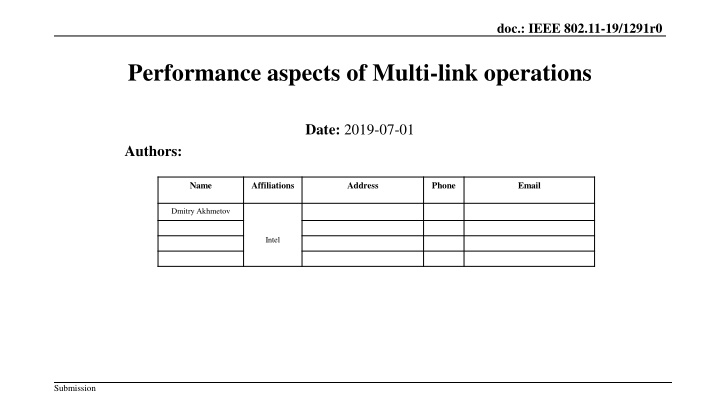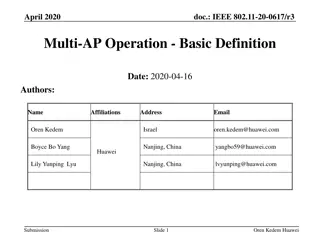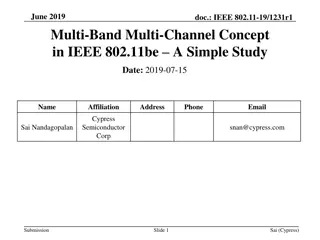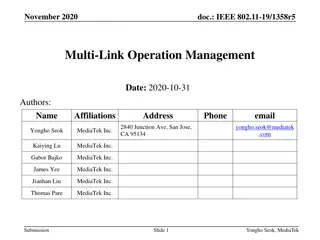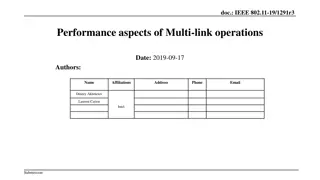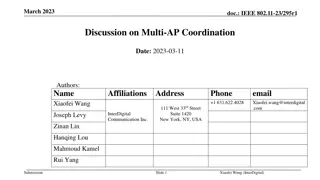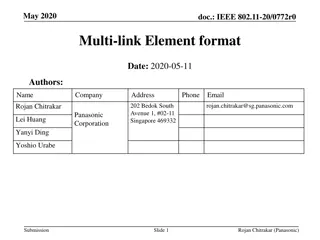Performance Aspects of Multi-link Operations in IEEE 802.11-19/1291r0
This document explores the performance aspects, benefits, and assumptions of multi-link operations in IEEE 802.11-19/1291r0. It discusses the motivation for multi-link operation in new wireless devices, potential throughput gains, classification of multi-link capabilities, and operation modes. The simulations by Mediatek and Qualcomm indicate significant throughput improvements with multi-link operations, leading to reduced end-to-end delay. The document also outlines synchronous, asynchronous, semi-asynchronous, and restricted operations in multi-link devices.
Download Presentation

Please find below an Image/Link to download the presentation.
The content on the website is provided AS IS for your information and personal use only. It may not be sold, licensed, or shared on other websites without obtaining consent from the author.If you encounter any issues during the download, it is possible that the publisher has removed the file from their server.
You are allowed to download the files provided on this website for personal or commercial use, subject to the condition that they are used lawfully. All files are the property of their respective owners.
The content on the website is provided AS IS for your information and personal use only. It may not be sold, licensed, or shared on other websites without obtaining consent from the author.
E N D
Presentation Transcript
doc.: IEEE 802.11-19/1291r0 Performance aspects of Multi-link operations Date: 2019-07-01 Authors: Name Affiliations Address Phone Email Dmitry Akhmetov Intel Submission
doc.: IEEE 802.11-19/1291r0 Motivation for Multi-link operation. STA 1 New wireless devices are expected to have multi-band/channel capabilities These new devices will/may be able to operate on different channels/band independently Independent channel access Independent TX / RX operation Unified TX/RX buffers for smooth and speedy operations Benefits Increased/improved throughput, better load handling Improved end-to-end latency Data/mgmt plane separation Potential for link aggregation Enable new use cases Link 2 Link 1 STA 2 Submission 2
doc.: IEEE 802.11-19/1291r0 Multi-link operation benefits STA 1 Obvious throughput performance numbers Mediatek in their simulations claim throughput gain of up to 2x-5x gain depending on link load & configuration Qualcomm in their simulations claim 1.1x-2.3x depending on links load Simple math says you can have 2x more water over 2 pipe than over 1 pipe Scales linearly with number of pipes Our internal simulations show the same 2x throughput gain over two links 2x in ideal case Less with extra load on each link Expected delay gain Theoretically up to 2x reduction of ETE delay but practically less Link 2 Link 1 STA 2 Submission 3
doc.: IEEE 802.11-19/1291r0 Multi-link operation assumptions and classification Assumptions A multi-link capable device perform channel access on multiple channels independently A multi-link device after obtaining TXOP on multiple bands/channels can transmit frames to the receiver(s) over multiple links Classification Synchronous operation Asynchronous operation Semi-Asynchronous operation Restricted operations Submission 4
doc.: IEEE 802.11-19/1291r0 Classification: Completely synchronous Existing 80+80 type operation TXOP TXOP TXOP band 1 3 2 2 1 1 0 0 3 2 1 0 AP1 busy TXOP busy busy band 2 AP2 Good old where is my secondary channel style Perform contention on primary channel Do energy detect on secondary If IDLE transmit over two channels If BUSY transmit on primary only Submission 5
doc.: IEEE 802.11-19/1291r0 Classification: Completely asynchronous TXOP TXOP busy band 1 2 5 4 1 3 0 6 9 8 7 3 2 1 0 AP1 TXOP busy TXOP TXOP band 2 3 2 0 1 0 2 1 4 3 2 1 0 AP2 Perform contention independently on both links Transmit/receive independently on both links Submission 6
doc.: IEEE 802.11-19/1291r0 Classification: Semi-asynchronous TXOP TXOP TXOP TXOP band 1 0 2 1 4 3 7 6 5 8 9 3 2 1 0 AP1 busy TXOP busy TXOP band 2 4 3 2 1 0 7 6 2 1 0 AP2 Perform contention independently If one channel/link won contention it can invite another link into the transmission opportunity If second link is in IDLE/Contention state transmit jointly Otherwise transmit using one link only Submission 7
doc.: IEEE 802.11-19/1291r0 DL case. Simulation setup. AP1 and AP2 on separate non-overlapping channels with 1 associated STA each SU HE, 2x2x80, MCS11 BSS load: UDP traffic in DL direction with load of Percentage of MCS11 @ 2x2x80 rate (of ~1.2Gbps) : 25% - 300Mbps, 50% - 600Mbps and 100% - 1.2Gbps 1 to 10 OBSSes with bidirectional UDP traffic with total load pre OBSS of 10% of MCS11 at each channel Each OBSS consist of 1 AP and 1 STA TXOP limit of 5.4ms Randomized TXOP limit for OBSS, uniformly distributed between 1ms and 5.4ms No TXOP bursting Metrics of interest Throughput # of synchronous/asynchronous operations and ratio of the two Synchronous operation simultaneous transmission start on both links Submission 8
doc.: IEEE 802.11-19/1291r0 Naming convention Single Single link operation Sync Single link 80+80 type operation Async Fully asynchronous operation Join Semi-asynchronous operation Submission 9
doc.: IEEE 802.11-19/1291r0 Single link vs Multi-link. DL case Submission 10
doc.: IEEE 802.11-19/1291r0 Single link vs Multi-link. DL case Submission 11
doc.: IEEE 802.11-19/1291r0 Single link vs Multi-link. DL case Submission 12
doc.: IEEE 802.11-19/1291r0 Chances of synchronous operation. Submission 13
doc.: IEEE 802.11-19/1291r0 DL / UL case. Simulation setup. AP1 and AP2 on separate channels with 1 associated STA each SU HE, 2x2x80, MCS11 BSS load: symmetrical UDP traffic in DL and UL direction with total BSS load of Percentage of MCS11 @ 2x2x80 rate (of ~1.2Gbps) 25% - 300Mbps, 50% - 600Mbps and 100% - 1.2Gbps 1 to 10 OBSSes with bidirectional UDP traffic with load of 10% of MCS11 at each channel Each OBSS consist of 1 AP and 1 STA TXOP limit of 5.4ms Randomized TXOP limit for OBSS, uniformly distributed between 1ms and 5.4ms No TXOP bursting Metrics of interest Throughput # of synchronous/asynchronous operations and ratio of the two Synchronous operation simultaneous transmission start on both links Submission 14
doc.: IEEE 802.11-19/1291r0 Single link vs Multi-link. DL/UL mix case Submission 15
doc.: IEEE 802.11-19/1291r0 Single link vs Multi-link. DL/UL mix case Submission 16
doc.: IEEE 802.11-19/1291r0 Single link vs Multi-link. DL/UL mix case Submission 17
doc.: IEEE 802.11-19/1291r0 Chances of synchronous operation, DL / UL mix case. Submission 18
doc.: IEEE 802.11-19/1291r0 Intermediate conclusion 2 links is definitely better than 1 link With lightly loaded networks 2x gain can be achieved The gain decreases with the increase of a load Semi-asynchronous operation outperform on average all other modes Chances for synchronous operations (concurrent) on two bands (i.e. to obtain channel at the same time) are not high Quickly dropping to ~5% and below as the load increases Submission 19
doc.: IEEE 802.11-19/1291r0 Complicated life of a device with co-located radios May need to impose constraints on concurrent TX/RX operations on different bands For, example, interference across links/radios - TX on band 1 can impact radio on band 2 (and vice versa). Devices radio capabilities / implementation may not allow for concurrent operation No TX operation is possible on band1 if band 2 is busy with RX operation and vice versa TXOP TXOP Tx data Tx data Tx data Rx ack Rx ack Rx ack band 1 3 2 1 0 4 3 2 1 0 5 AP1 TXOP TXOP Rx ack Tx ack R x Tx data Rx data Tx data band 2 Tx data Tx Rx ack Rx ack 3 2 AP2 Submission 20
doc.: IEEE 802.11-19/1291r0 Simulation setup. Traffic load, PHY config, etc. is the same as before Semi-synchronous with restrictions mode of operation restricted join Asynchronous with restrictions mode of operation restricted async Channel access rules / TX operations restrictions/constraints Device has to meet the constraints by truncating or deferring own TX operations o Suspend\restart backoff during possible overlapping operation o If the other Device in TX state, limit own TX duration to match end of the other AP transmission Submission 21
doc.: IEEE 802.11-19/1291r0 Restricted vs Unrestricted. DL case Submission 22
doc.: IEEE 802.11-19/1291r0 Restricted vs Unrestricted. DL case Submission 23
doc.: IEEE 802.11-19/1291r0 Restricted vs Unrestricted. DL case Submission 24
doc.: IEEE 802.11-19/1291r0 Chances of synchronous operation Submission 25
doc.: IEEE 802.11-19/1291r0 Restricted vs Unrestricted. DL/UL mix case Submission 26
doc.: IEEE 802.11-19/1291r0 Restricted vs Unrestricted. DL/UL mix case Submission 27
doc.: IEEE 802.11-19/1291r0 Restricted vs Unrestricted. DL/UL mix case Submission 28
doc.: IEEE 802.11-19/1291r0 Chances of synchronous operation Submission 29
doc.: IEEE 802.11-19/1291r0 Conclusion For STAs without Tx/Rx constraints, asynchronized access performs very well, as expected For STAs that have Tx/Rx constraints, asynchronized access with restrictions preform much better than fully synchronized access Average performance gain from multi-link operation Asynchronous operation, DL case: 2.07x Asynchronous operation, DL / UL mix case: 2.02x Semi-asynchronous operation, DL case: 2.28x Semi-asynchronous operation, DL / UL mix case: 2.22x Restricted asynchronous operation, DL case: 1.91x Restricted asynchronous operation, DL / UL mix case: 2.09x Restricted semi-synchronous operations , DL case : 2.22x Restricted semi-synchronous operations , DL / UL mix case : 2.21x Completely synchronous operation, DL case: 1.27x Completely synchronous operation, DL / UL mix case: 1.29x Submission 30
